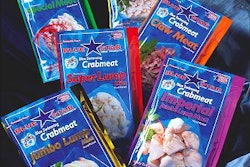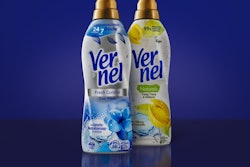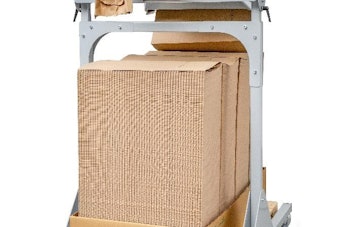
Packaging from Ecolab Inc., St. Paul, MN, must meet the requirements for two discerning groups: its customers and the United Nations. The company’s Oasis Pro™ concentrated cleaners in 2-L stand-up pouches also met the criteria of another critical group: the Institute of Packaging Professionals. IoPP judges awarded Ecolab’s stand-up pouch a 2003 AmeriStar Award in the “Regulated Packaging” category (see www.packworld.com/go/c090).
“It was difficult to find a pouch material that would be compatible with all of these highly concentrated chemicals and meets the United Nation’s regulatory requirements for shipment of hazardous materials,” explains Tom Berg, Ecolab project engineer. “We ended up with a very unique package.”
Oasis Pro™, a lineup of 22 different products including glass, carpet, and toilet bowl cleaners, are sold to institutions in the hospitality, healthcare, and foodservice sectors.
Unlike typical stand-up pouches, the Oasis Pro 10”x9” custom pouch, made of material 6 mils thick, rests on a broader-than-normal 5’’-wide gusseted base to give it stability in a squat, compact shape. Ecolab chooses not to disclose the pouch supplier.
The pouch compacts easily after use and is capable of being incinerated, which is desirable for many industries including its cruise line customers where waste storage is a major concern, Ecolab states.
The pouch incorporates an IPN Clean Clic™ dispensing fitment that permits a quick-connect to Ecolab’s dispensing system. This technology is exclusive to Ecolab in their markets. Ecolab liked that the fitment is injection-molded in one piece, which helps eliminate the possibility of customers’ direct contact with the cleaners. It has a 4-mm orifice. Ecolab packaging director Jane Chase says that the fitment, which the pouch supplier heat seals into the pouch’s angled corner, was a challenging development.
“With the fitment, the user is never in contact with any of the product,” says Chase. She points out that the fitment acts as a one-way flow valve; when the filling or dispensing probe is retracted, the fitment reseals itself, so the pouch and fitment remain sealed when not in use.
The pouches are decorated with a two- color pressure-sensitive label. The label structure has to withstand the range of powerful chemicals that run from surfactants to caustic to acidic formulations. The product labels are color coded to match the appropriate dispensing location on the Oasis Pro Dispensing System. For example, the pink label on the Marble Safe Cleaner indicates to the customer that it should be placed in the dispensing location with the pink label, thereby reducing the likelihood of user error.
The pouches are filled using a single-head, semi-automated table-top gear pump filler that is a new system for Ecolab. The filling probe fills through the fitment. As the fill probe is removed, the pouch fitment reseals. This process of filling eliminates air in the pouch, decreasing the time required for the customer to prime the dispenser.
The filled 2-L pouches are packed two per cubical case. The 8¼’’x6½’’x7½’’ 200# test, B-flute corrugated case is flexo-printed on mottled white liner in two colors. A C-Flute corrugated divider separates and protects both pouches during shipment and storage. Packed two pouches per case, the products are shipped 198 cases per pallet. While the pallet cube efficiency has increased nominally from 82% to 87%, the volume of product per pallet has increased 42%.
An integrated effort
Launched in early 2003, the pouch is a transition from 32-oz high-density polyethylene bottles and, primarily, 2½-gal HDPE jugs. In the rigid-to-flexible change, Ecolab initiated further source reduction by converting to more concentrated solutions, twice the strength as before. This change represents an 82% reduction in packaging weight.
The new packaging improves the safety, storage requirements, and usage of the products, says Ecolab senior marketing manager Randy Lia.
“Going to the smaller package was another benefit customers were asking for,” Lia says, noting that the 2½-gal jug could weigh 28 lb. “It’s a smaller package that’s easier to handle, lighter to move around, and takes up less space.”
Feedback with the bottled format indicated customers had two primary complaints, according to Lia: leakage and employee contact with chemicals.
“We did two things to address those concerns,” Lia says. “We made the package upright, and we’ve ‘sealed’ the chemistry. This improves product safety and consistency, and makes it very challenging for employees to get in contact with the chemical.”
Unbottled safety
Prior to the introduction of the Oasis Pro System, Ecolab customers stored bottles on racks and mixed their solutions as needed. “Customers have always faced the challenge of misuse and improper dilution by their employees,” explains Lia. “Often, employees have the mentality that if a little works well, more works even better, so they were manually mixing the product at stronger dilutions than necessary.”
Customers store the Oasis Pro pouches inside a custom designed dispenser cabinet. Tube connections made through the spout permit direct dispensing into spray bottles (at a rate of 1-gal/min) or mop buckets (4-gal/min) according to the dial-in settings. Up to four different products can be contained in the integrated dispenser cabinet. The pouch is designed to be evacuated while upright to prevent the chance of product leakage.
“We designed the pouch, dispenser, and cabinet connections to work together,” Lia says. “Color coding simplifies the system and ensures the proper product and dilution ratios are used.
“This is a global program that was co-developed with our Ecolab colleagues in Europe and launched both in Europe and in the United States simultaneously,” he adds. The products are sold throughout those two regions as well as in Canada.
The secondary and primary packaging is printed with English, Spanish, and French copy. Information cards are available providing copy in five additional languages, according to Lia. Pricing ranges from $30 to $100 per case, each packed with two 2-L pouches.
“Sales have clearly exceeded our expectations for the first full year,” says Lia. “The concept has been highly embraced by our primary customers—hospitality and healthcare housekeeping areas. A large part of our success can be attributed to the packaging. This packaging gets customers very interested because of the benefits they immediately see.”
And what about the award? “It was exciting to see our package as a winner among the more glamorous retail packaging which is usually designed for appearance over function,” says Berg. “Our package is strictly about functionality, so it was very rewarding to be recognized for our functional design along with the more traditional winners.”























